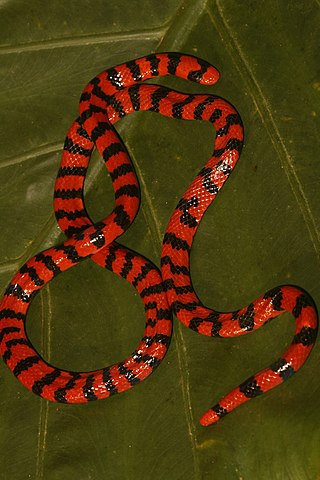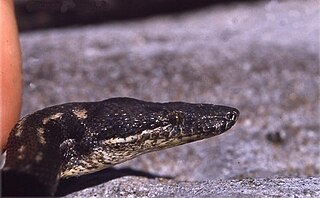The Crotalinae, commonly known as pit vipers, or pit adders, are a subfamily of vipers found in Eurasia and the Americas. Like all other vipers, they are venomous. They are distinguished by the presence of a heat-sensing pit organ located between the eye and the nostril on both sides of the head. Currently, 23 genera and 155 species are recognized: These are also the only viperids found in the Americas. The groups of snakes represented here include rattlesnakes, lanceheads, and Asian pit vipers. The type genus for this subfamily is Crotalus, of which the type species is the timber rattlesnake, C. horridus.

The Typhlopidae are a family of blind snakes. They are found mostly in the tropical regions of Africa, Asia, the Americas, and all mainland Australia and various islands. The rostral scale overhangs the mouth to form a shovel-like burrowing structure. They live underground in burrows, and since they have no use for vision, their eyes are mostly vestigial. They have light-detecting black eye spots, and teeth occur in the upper jaw. Typhlopids do not have dislocatable lower jaw articulations restricting them to prey smaller than their oral aperture. The tail ends with a horn-like scale. Most of these species are oviparous. Currently, 18 genera are recognized containing over 200 species.

The Anomalepididae are a family of nonvenomous snakes, native to Central and South America. They are similar to Typhlopidae, except that some species possess a single tooth in the lower jaw. Currently, four genera and 15 species are recognized. Common names include primitive blind snake and dawn blind snake.

The Aniliidae are a monotypic family created for the monotypic genus Anilius that contains the single species Anilius scytale. Common names include the American pipe snake and false coral snake. It is found in South America. This snake possesses a vestigial pelvic girdle that is visible as a pair of cloacal spurs. It is ovoviviparous. It is non-venomous, and its diet consists mainly of amphibians and other reptiles. Two subspecies are recognized, including the nominate subspecies described here.

The Bolyeriidae are a family of snakes native to Mauritius and a few islands around it, especially Round Island. They also used to be found on the island of Mauritius, but were extirpated there due to human influence and foraging pigs in particular. These snakes used to be placed in the Boidae, but are now classed as a separate family. Two monotypic genera are recognized, but only a single species is extant. Bolyeriidae appear to be most closely related to the Asian genus Xenophidion.

Xenopeltis, the sunbeam snakes, are the sole genus of the monotypic family Xenopeltidae, the species of which are found in Southeast Asia. Sunbeam snakes are known for their highly iridescent scales. Three species are recognized, each one with no subspecies. Studies of DNA suggest that the xenopeltids are most closely related to the Mexican burrowing python and to the true pythons (Pythonidae).

The Boinae are a purported subfamily of boas found in Central and South America, as well as the West Indies. In the Integrated Taxonomic Information System (ITIS), Boinae is considered an invalid synonym of Boidae.

Typhlops is a genus of blind snakes in the family Typhlopidae. The genus is endemic to the West Indies. Some species which were formerly placed in the genus Typhlops have been moved to the genera Afrotyphlops, Amerotyphlops, Anilios, Antillotyphlops, Argyrophis, Cubatyphlops, Indotyphlops, Letheobia, Madatyphlops, Malayotyphlops, and Xerotyphlops.
Ramphotyphlops is a genus of nonvenomous blind snakes of the family Typhlopidae. Member species of the genus are native to southern Asia and southeast Asia, as well as many islands in the southern Pacific Ocean. They occur in a wide variety of habitats. Currently, 22 species are recognized as being valid.

Rhinotyphlops is a genus of blind snakes in the family Typhlopidae. The genus is found in Africa, the Middle East, and India. Some species formerly assigned to the genus Rhinotyphlops have been moved to the genera Afrotyphlops and Letheobia.

Liotyphlops is a genus of blind snakes in the family Anomalepididae. The genus is native to Central America and South America. It contains 13 species that are recognized as being valid.
Liotyphlops albirostris is a species of snake in the Anomalepididae family. It is endemic to Central America. The snake has been reported from Colombia, Curaçao, Panama and Venezuela.
Liotyphlops argaleus is a species of snakes in the family Anomalepididae. It is endemic to Colombia.

Liotyphlops beui is a species of nonvenomous snake in the family Anomalepididae. The species is native to northeastern Argentina, eastern Paraguay, and central-western, southeastern, and southern Brazil; the Reptile Database restricts its range to Brazil. It is locally common in Brazil. It is sometimes known as the pale-headed blindsnake.
Liotyphlops schubarti is a species of snake in the family Anomalepididae. The species is endemic to Brazil.
Liotyphlops wilderi is a species of snake in the family Anomalepididae. The species is endemic to Brazil.
The two-colored blind snake is a species of snake in the family Leptotyphlopidae. This species of snake are small, with a range usually between 15-20cm in length.

Namibiana occidentalis, also known as the western threadsnake or western worm snake, is a species of snake in the family Leptotyphlopidae. It is found in Namibia and north-western South Africa.
Sundatyphlops polygrammicus, also known as the Lesser Sunda blind snake or north-eastern blind snake is a species of snake in the Typhlopidae family.
The wedge-snouted blind snake, also known as the wedgenose blind snake, is a species of snake in the Typhlopidae family.









